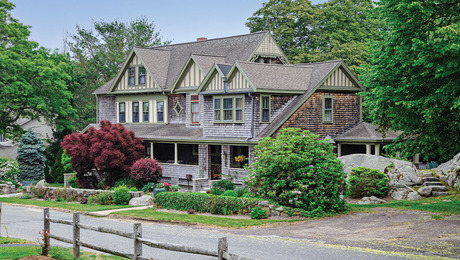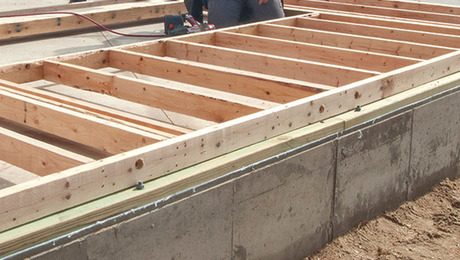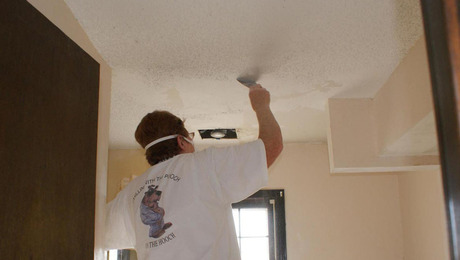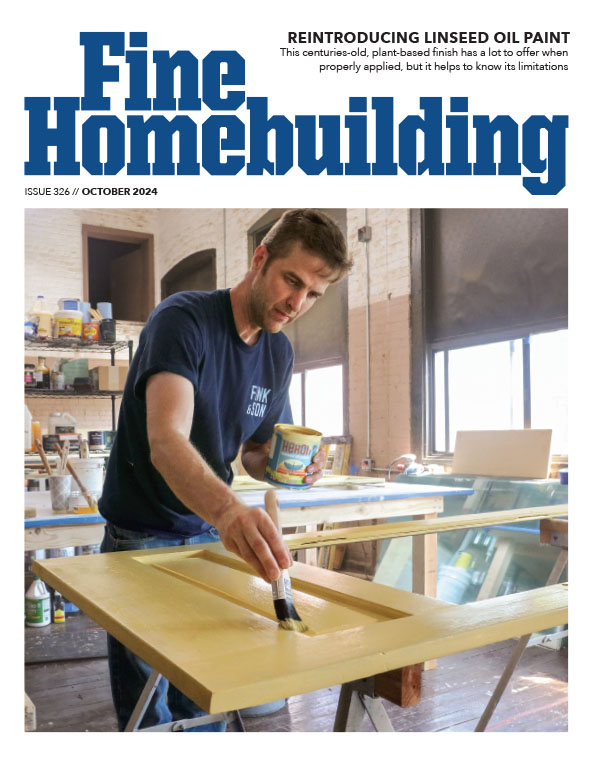Fire destroys cover house
We were shocked and saddened by the news that the house featured on the cover of this year’s HOUSES (FHB #116), “An Artfully Crafted Vermont Home,” was destroyed by fire on the morning of April 20. Owners Michelle and Joshua Rose and their three children were not in the house at the time of the fire. More than 40 firefighters worked for six hours to extinguish the blaze. According to reports later published in the Burlington Free Press, the fire was the result of arson. A local man, a member of the family that built the historic Shelburne Farms, was arrested and charged with setting the fire.
Ironically, builder John Seibert, author of our story about the house, received his copy of the magazine on the morning of the fire. Seibert said that everyone involved with building the house was in a state of disbelief. “After working with the Roses on this project for so long, the house became very special to all of us; it was a labor of love. We all assumed the house would be standing long after we were gone. It’s a terrible loss for the Roses.”
—The editors
Gluing sheathing in the cold, and without spacing?
I was impressed with the article on the framing and sheathing of floors in your June/July issue (FHB #117, pp. 52-59). I inspect homes that are involved with disputes and/or litigation regarding construction defects. An increasing number of these inspections concern the problem of floor squeaks.
The authors are heads above most contractors, and I am sure that they are experiencing fewer complaints and callbacks because of their system of installing subflooring. However, I do have some concerns that either were not addressed or were misleading in the article.
1. The adhesive manufacturers recommend an open time for the adhesives they sell. There was no mention of the suggested time between the application of the adhesive and the clamping (mechanical fastening) of the subfloor. This is important and often overlooked by the contractor.
2. The adhesive manufacturers also recommend a minimum temperature for the adhesive, and most recommend that the adhesive be stored at room temperature prior to application. The pictures with this article have snow in the background.
3. The APA recommends 1⁄8-in. spacing between panels. In this article, the contractor is using a sledge to pound the panels together. How are they maintaining the proper spacing?
—Wallace D. Corwin, product-integrity manager, JELD-WEN
Authors Rick Arnold and Mike Guertin reply: The open time listed on the two adhesives we’re currently using regularly are 20 minutes and 1 hour. Our experience has been that those times will vary with temperature. On a 90°F sunny day, we’re lucky to get 10 minutes, and during the winter at 30°F, we have a couple of hours, if not a whole day. In cold weather, we’ll often glue out a whole course of sheathing, but during the summer we may only do one sheet at a time and nail it off as we go. Site conditions vary so much that it would be difficult to instruct someone on the finer points of gluing. The most important thing we could tell anyone is to use it.
During the winter, we use an adhesive that’s $1 more a tube because it has a working temperature down to 0°F (PL Premium Polyurethane Construction Adhesive, ChemRex Inc.; 800-433-9517). We do like to keep our adhesives inside at night, but by afternoon they’re the same temperature as the sheathing and framing. Keeping the tubes of glue warm probably reduces the fatigue of dispensing, but as soon as the recommended 3⁄8-in. bead gets sandwiched between the 28°F joist and 28°F oriented strand board, it’s probably 28°F.
We have a novel way of spacing our structural panels. We put lots of glue in the way so that we have to use a sledge to get the panels within 1⁄8 in. Seriously, we’ve never experienced a problem. Maybe we’re just lucky. But ask 100 builders at random if they space their sheathing, and let us know what they say. Meantime, we’re still waiting for the 477⁄8-in. by 957⁄8-in. sized-for-spacing sheathing to show up at our local lumber supplier.
Floor squeaks aren’t a construction defect unless they are due to loose (improperly nailed) subfloor. We rarely have squeaks in our floors, probably because we use glue, but we’ve had clients who get one or two and go berserk. Rhode Island actually has some performance guidelines that are part of our building-contractor registration law. The specification states that floor squeaks are not a construction defect. NAHB’s Residential Construction Performance Guidelines (1996) note that “ … totally squeak-proof floors cannot be guaranteed.” We’re not proponents of squeaky floors, but clients and home inspectors must understand the materials we build with and the limitations of the systems used to construct homes.
That’s not Buddha picking his nose
On p. 105 of the June/July issue (FHB #117), a small ceramic figure is described as a “smiling Buddha.” There are strict guidelines in the depiction of Buddha, which I believe do not include showing the Buddha figure picking his nose. Rather, the figure appears to be a reproduction of a European medieval decorative detail, which is currently seen for sale in many catalogs. I am not a Buddhist, but I imagine this erroneous caption would be shocking for an adherent of the Buddhist faith.
All that aside, I enjoy and look forward to your publications very much.
—Carmen Van Noy, Mammoth Lakes, CA
The elements of camp style vary regionally
In your article “A New Camp-Style House,” (FHB #117, pp. 104-109), you feature a beautiful New Hampshire retreat. The article accurately explains that camp is the Northeastern term for a rustic summer house.
I was most interested in the article’s sidebar, which lists the elements of camp style, including red-cedar sidewall shingles, copper flashings and drip edges, oak floors downstairs and slate tiles in the entry.
Where I live in northern Vermont—a short distance away from your featured house in New Hampshire—the elements of camp style are just a little different. My research has revealed that the Vermont camp style includes roll roofing for siding, plywood floors and the use of old vehicle seats for furniture.
I am still doing the calculations to figure whether these elements of Vermont camp style can be achieved for less than $130 per sq. ft., the price of your featured retreat.
—Martin Holladay, Sheffield, VT
Row-house date was incorrect
Although I enjoyed seeing the sophisticated design for the renovation of the small Philadelphia town house in your April/May issue (FHB #115, pp. 78-81), a historical error must be pointed out. The house could not have been built in 1752, as noted in the article, because the neighborhood in which it was built was not developed until well into the 19th century.
I am guessing that the author assumed the date based on the plaque hung on the front facade of the house showing four interlocked hands and the date 1752. These plaques and ones of similar design are found on houses all over Philadelphia. They originally were signs that the house was protected by the private fire company indicated. The Hand-in-Hand Fire Company, whose symbol adorns the house pictured in your layout, was founded in 1742 and merged in 1752 with the Union Fire Company, which was founded by Benjamin Franklin in 1736 as the first fire company in the colonies. Without the plaque, your house would not be protected. Of course, once fire safety became an issue of public concern, these signs lost their meaning.
Based on its location and style, this row of small worker houses was most likely built after 1840. If it had been built in 1752, I am sure it would have been a much more difficult renovation than it probably was.
—Kevin Aires, Philadelphia, PA
More opinions on the rafter-cutting article
Good grief! Don’t you guys proofread an article for readability before publishing? John Carroll’s article “A Different Approach to Rafter Layout” (FHB #115, pp. 92-97) just made my eyes glaze over. Mr. Carroll brags how he can make a rafter jig and lay out the rafters of a roof in less than ten minutes on a wager of a six pack of imported beer. I think Mr. Carroll had one too many beers when he wrote the article. It took me 20 minutes to read the article, and when I finished, I felt like I had consumed the six pack. I had not the slightest idea of how he constructed the jig or how it was used. I could name numerous other Fine Homebuilding articles that babble on just like this one. Mr. Carroll says, “If you’ve always been vexed by roof framing, I think you’ll find my way easier to understand than most.” Well, I’m still vexed. Pour me another beer.
—Mike Gleason, Welch, MN
I’d like to respond to Daniel Myrick’s letter (FHB #117, “Letters,” p. 8) about John Carroll’s rafter-cutting article. I don’t know who Daniel Myrick thinks reads Fine Homebuilding, but I can tell him that anybody with an attitude like his on one of my job sites would find himself digging holes for Sonotube down to the frost line with a plastic soup spoon. Around here, the frost line is between 5 ft. and 6 ft. down, too.
John Carroll’s approach to laying out common rafters may not be the final answer for everybody, but it shows that the guy understands what he’s doing, and more important, it works for him. He’s also developed a method that won’t cease to function when the batteries go dead in Mr. Myrick’s Construction Master.
Just to bug Mr. Myrick a little more, I should mention that my method for laying out roofs definitely involves “scaling” rafters and ridges, etc., from the drawings. What does he think drawings are for, anyway? I suppose he’s one of those guys who refer to the plans and specs of a house as “the joke book.” While I’m perfectly capable of building a shed, deck or house without anything on paper, keeping it all in my head and measuring out one piece of wood at a time, it goes a lot faster when all the geometry has been prefigured in the comfort of my study. I love being outside in the fresh air, or I wouldn’t do what I do for a living. But sines, cosines and square roots go better with slippers than my steel-toed work boots.
—T. H. Richards, Mont Tremblant, PQ, Canada
Debating the value of bridging
No bridging on the East Coast! Next thing you know, they’ll be using worm-drive saws!
I enjoyed the article “Framing and Sheathing Floors” (FHB #117, pp. 52-59) and was especially glad to have the authors tell us that bridging adds little or nothing to the structural integrity of a floor frame. It is important to block joists where they tie together over bearing walls, but you can say no to midspan bridging. West Coast codes haven’t called for such bridging for around 30 years. If the floor sheathing is applied properly, then about all you get from bridging is squeaks.
—Larry Haun, Coos Bay, OR
I don’t believe Rick Arnold and Mike Guertin understand much about structure to recommend no bridging (FHB #117, p. 59). Properly done, good bridging, which is solid blocking, tightly fit and staggered for nailing, can greatly increase the strength of any floor—the neighboring joists share the load, or flexing will occur. Single-joist deflecting will certainly occur with heavy concentrated or moving loads.
We use 11⁄8-in. tongue-and-groove plywood, screwed and glued to joists, which are always solid-blocked over 8 ft., making a solid floor. (By the way, this plywood floor is one of the best things that has come into the building business in many years.) When we walk in a room and find 2,000 lb. or 3,000 lb. of drywall piled in the middle, we sure appreciate the solidity of a floor system where all the parts are working together.
—Cole Smith, Dallas, TX
Quit bashing architects
Regarding Todd Remington’s essay “Architects Should Learn How to Build” (FHB #116, “Commentary,” pp. 26, 28), it’s almost becoming a regular feature in the HOUSES issue of your magazine to see some disgruntled architect bashing other architects for this or that. While this may play well to your mostly builder audience, such articles do little to promote cooperation and respect between these professions. A builder who is not hostile to an architect’s intent is as valuable as an architect who can gracefully receive some real-world tips from a builder early in the design phase. The fact is, there are lousy architects, and there are lousy builders. Casting doubt over the architectural profession while presenting architects’ work in your magazine is a questionable policy and can only widen the gulf between us.
—Larry Larson, via e-mail
Maybe you’re right to bash architects
As a project designer of 20 years in the architectural field, I have to agree with Todd Remington’s essay “Architects Should Learn How to Build” (FHB #116, “Commentary,” pp. 26, 28). I have seen a real change of attitude in the architectural field over the past few years. So many of the new architects come out of school “knowing it all” and do not want to learn anything beyond their schooling.
In the past, school was only the beginning. When the graduate started his apprenticeship, his education really began. He learned from a master the practical side of architecture and how things were built. Today, students graduate and start designing. They do not know how things go together. If you try to teach them how to put a construction package together that makes the contractor’s job easy and keeps construction costs in the budget, they aren’t interested.
There is a trend in commercial building toward design-built buildings in which the builder controls the whole project. This eliminates the architect’s control. The designs are not artistic but functional and abide within a budget. This is happening in the housing industry with tract homes. Custom-home builders are using in-house designers as well.
So what happens to the architect? Can architecture as art survive? I think that the American Institute of Architects needs to take a good look at where its industry is going.
—David Kipf, Berthoud, CO
Fine Homebuilding Recommended Products
Fine Homebuilding receives a commission for items purchased through links on this site, including Amazon Associates and other affiliate advertising programs.

Reliable Crimp Connectors

8067 All-Weather Flashing Tape

Affordable IR Camera


















